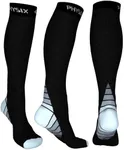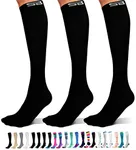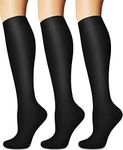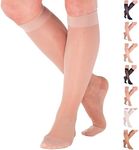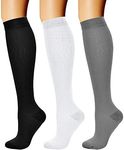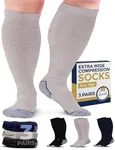Buying Guide for the Best Travel Socks For Airplane
Travel socks for airplanes are designed to provide comfort and support during long flights. They help in reducing swelling, improving circulation, and preventing deep vein thrombosis (DVT). When choosing the right pair of travel socks, it's important to consider several key specifications to ensure you get the best fit for your needs.Compression LevelCompression level refers to the amount of pressure the socks apply to your legs. This is important because it helps improve blood circulation and reduce swelling. Compression levels are usually measured in millimeters of mercury (mmHg). Light compression (8-15 mmHg) is suitable for mild swelling and general comfort. Moderate compression (15-20 mmHg) is ideal for those who experience moderate swelling or discomfort during flights. Firm compression (20-30 mmHg) is recommended for individuals with more severe swelling or those at risk of DVT. Choose a compression level based on your personal comfort and any medical conditions you may have.
MaterialThe material of travel socks affects their comfort, breathability, and durability. Common materials include cotton, nylon, spandex, and merino wool. Cotton is soft and breathable but may not provide as much support. Nylon and spandex offer good elasticity and support, making them ideal for compression socks. Merino wool is excellent for temperature regulation and moisture-wicking, keeping your feet dry and comfortable. Consider your personal preferences and any allergies when choosing the material.
Fit and SizeProper fit and size are crucial for the effectiveness of travel socks. Ill-fitting socks can cause discomfort and reduce their benefits. Travel socks come in various sizes, often based on shoe size or calf circumference. Measure your calf circumference and refer to the sizing chart provided by the manufacturer to ensure a snug but comfortable fit. If you are between sizes, it's usually better to choose the larger size to avoid excessive tightness.
LengthTravel socks come in different lengths, such as ankle, crew, and knee-high. The length you choose depends on your comfort and the level of support you need. Ankle-length socks provide minimal support and are suitable for short flights or mild swelling. Crew-length socks offer more support and are ideal for moderate swelling. Knee-high socks provide the most support and are recommended for long flights or individuals at risk of DVT. Consider the duration of your flight and your personal comfort when choosing the length.
Moisture-WickingMoisture-wicking properties help keep your feet dry by drawing sweat away from the skin. This is important for maintaining comfort and preventing odor during long flights. Look for socks made with moisture-wicking materials like merino wool or synthetic fibers. If you tend to sweat a lot or are traveling to a warm destination, prioritize socks with good moisture-wicking capabilities.
CushioningCushioning refers to the padding in the socks that provides extra comfort and support. This is important for reducing foot fatigue and providing a comfortable experience during long flights. Socks with extra cushioning in the heel and toe areas can help prevent blisters and soreness. If you have sensitive feet or plan to walk a lot during your travels, look for socks with ample cushioning.
